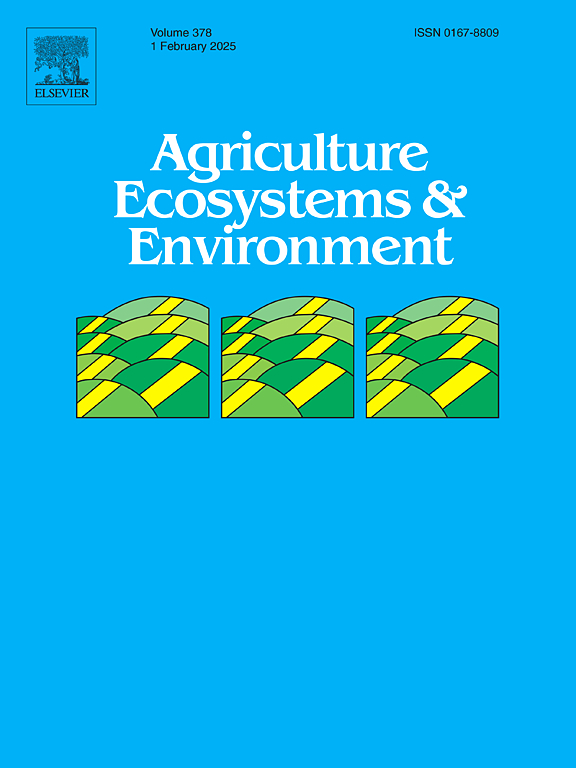施用尿素后抑制剂和缝隙加入对 NH3 和 N2O 排放过程的影响
IF 6.4
1区 农林科学
Q1 AGRICULTURE, MULTIDISCIPLINARY
引用次数: 0
摘要
农业中使用尿素肥料会对环境造成许多负面影响,是氨气(NH3)和一氧化二氮(N2O)的排放源。尿素肥料造成的这些损失可以通过不同的减缓技术加以避免。在土壤持水量为 70% 的砂质壤土上,比较了三种不同的缓解原理,即单独使用脲酶抑制剂(N-(2-硝基苯基)磷酸三酰胺,2-NPT)(UI)、脲酶抑制剂与硝化抑制剂(N-[3(5)-甲基-1H-吡唑-1-基]甲基]乙酰胺,MPA)(NI)以及将尿素肥料封闭式掺入土壤。采用开放式动态培养室的离体微生态系统方法,通过清洗瓶子采集 NH3 样本,监测两周内的 NH3 排放量。通过连续气相色谱(GC)测量,在慢速通流中观培养箱中研究了十周的一氧化二氮排放情况。为了深入了解 N2O 的产生和消耗过程,在六周后采集了气体样本,并通过同位素比质谱(IRMS)分析了 N2O 同位素。与表面施用尿素相比,狭缝喷射对减少 NH3 排放的作用最大,减少了 79.6%(UI 为 40.6%,UINI 为 46.7%)。在试验开始时,由于加入尿素,出现了轻微的 N2O 污染交换,但在整个培育期间的累积排放量中没有出现这种情况。随着时间的推移,UINI 对 N2O 排放量的减少作用逐渐减弱,在试验结束时累计排放量没有减少。N2O 同位素证实硝化作用对 N2O 的产生有很大作用。相比之下,细菌反硝化、硝化细菌反硝化和真菌反硝化的参与程度要低得多,N2O 还原成 N2 的效果也不明显。所有减少 NH3 排放的措施都能有效减少 NH3 排放,而它们对 N2O 排放的影响则随时间而变化。作物对氮的吸收和降雨等因素会进一步改变对 N2O 排放的总体影响,因此在进行最终的污染交换评估时需要加以考虑。需要进一步研究 NI 对非目标微生物群落的影响,以阐明潜在的环境后果和抑制剂化合物的长期功效。本文章由计算机程序翻译,如有差异,请以英文原文为准。
Effects of inhibitors and slit incorporation on NH3 and N2O emission processes after urea application
The use of urea fertilizers in agriculture is associated with many negative environmental impacts and is a source of ammonia (NH3) and nitrous oxide (N2O) emissions. Such losses from urea fertilizer can be avoided by different mitigation techniques. Three different mitigation principles, urease inhibitor (N-(2-Nitrophenyl) phosphoric triamide, 2-NPT) (UI) alone and urease inhibitor in combination with nitrification inhibitors (N-[3(5)-methyl-1 H-pyrazol-1-yl) methyl] acetamide, MPA) (NI) and closed slit incorporation of urea fertilizer into the soil, were compared on a sandy loam soil at a soil water level of 70 % water-holding capacity. An in vitro microcosm approach with open dynamic incubation chambers was used to monitor NH3 emissions over two weeks with NH3 sampling by washing bottles. N2O emissions were studied over ten weeks in slow throughflow mesocosms with continuous gas chromatographic (GC) measurements. To get insights into N2O production and consumption processes, gas samples were taken after six weeks and N2O isotopocules were analyzed by isotope ratio mass spectrometry (IRMS). Slit injection showed the greatest effect on NH3 emission reduction by 79.6 % (40.6 % by UI, and 46.7 % by UINI) compared to surface applied urea. Minor pollution swapping to N2O was observed at the beginning of the trial due to incorporation but not in the cumulative emissions over the entire incubation time. The reduction effect of UINI on N2O emissions decreased over time with no cumulative emission reduction at the end of experimentation. N2O isotopocules confirmed the high contribution of nitrification to N2O production. In contrast and bacterial denitrification, nitrifier denitrification and fungal denitrification were involved on a much lower level and N2O reduction to N2 was not pronounced. All NH3 mitigation measurements where effective to decrease NH3 emissions while their effects on N2O emission varied over time. Factors as crop N uptake and rainfall would further modify the overall effect on N2O emissions and need to be considered for final pollution swapping assessment. Further research on the impact of NI on non-target microbial communities is warranted to elucidate potential environmental consequences and long-term efficacy of inhibitor compounds.
求助全文
通过发布文献求助,成功后即可免费获取论文全文。
去求助
来源期刊

Agriculture, Ecosystems & Environment
环境科学-环境科学
CiteScore
11.70
自引率
9.10%
发文量
392
审稿时长
26 days
期刊介绍:
Agriculture, Ecosystems and Environment publishes scientific articles dealing with the interface between agroecosystems and the natural environment, specifically how agriculture influences the environment and how changes in that environment impact agroecosystems. Preference is given to papers from experimental and observational research at the field, system or landscape level, from studies that enhance our understanding of processes using data-based biophysical modelling, and papers that bridge scientific disciplines and integrate knowledge. All papers should be placed in an international or wide comparative context.
 求助内容:
求助内容: 应助结果提醒方式:
应助结果提醒方式:


